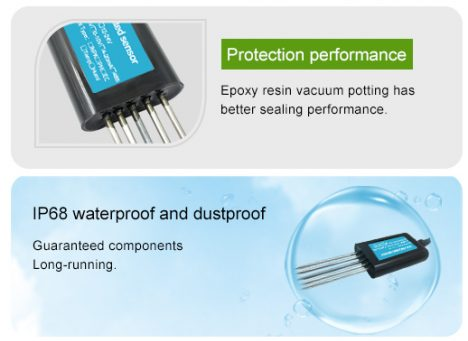Soil sensor play a crucial role in modern agriculture, environmental monitoring, and land management practices. These innovative devices provide real-time data on key soil parameters, allowing people to make informed decisions. From monitoring soil moisture levels to assessing nutrient availability and soil compaction, soil sensors offer a wide range of applications that contribute to sustainable agriculture, environmental conservation, and efficient land use.
In this article, we will explore the diverse applications of soil sensors and their significance in various fields.
Types of Soil Sensors
Soil Moisture Sensors:

- Soil moisture sensors measure the water content in the soil, providing valuable information on irrigation needs, water availability for plants, and soil health. These sensors help optimize water use efficiency, prevent over-irrigation, and reduce water wastage in agriculture.
Soil Temperature Sensors:
- Soil temperature sensors monitor the temperature of the soil, which influences seed germination, plant growth, and microbial activity. By tracking soil temperature variations, farmers can adjust planting schedules, manage crop growth stages, and mitigate frost risks.
Soil Nutrient Sensors:

- Soil nutrient sensors measure the concentrations of essential nutrients such as nitrogen, phosphorus, and potassium in the soil. These sensors help farmers optimize fertilizer application, prevent nutrient deficiencies, and improve crop yields while minimizing environmental impact.
Soil pH Sensors:

- Soil pH sensor monitor the acidity or alkalinity of the soil, which affects nutrient availability, plant growth, and soil microbial activity. By measuring soil pH levels, farmers can adjust soil amendments, select suitable crops, and maintain optimal soil conditions for plant growth.
Soil Salinity Sensor:
- Soil salinity sensor measure the salt content in the soil, which can affect plant growth, soil fertility, and water quality. By monitoring soil salinity levels, farmers can manage salt-affected areas, select salt-tolerant crops, and prevent soil degradation due to salinity.
Applications of Soil Sensors
Soil sensor have diverse applications in agriculture, environmental monitoring, and land management practices. Some common applications of soil sensors include:

Precision Agriculture:
- Soil sensor are use in precision agriculture to optimize resource use, enhance crop productivity, and reduce environmental impact. By monitoring soil moisture, nutrients, and other parameters, farmers can implement site-specific management practices, adjust inputs, and increase agricultural efficiency.
Irrigation Management:
- Soil moisture sensor play a critical role in irrigation management by providing real-time data on soil water content. Farmers can use this information to schedule irrigation, prevent water stress, and improve water use efficiency in crop production.
Nutrient Management:
- Soil nutrient sensor help farmers monitor nutrient levels in the soil and adjust fertilizer application rates accordingly. By optimizing nutrient management, farmers can reduce fertilizer waste, minimize nutrient runoff, and enhance crop nutrient uptake for improved yields.
Soil Health Monitoring:
- Soil sensor are assess soil health indicators such as soil moisture, temperature, pH, and compaction. By monitoring these parameters, farmers can evaluate soil quality, identify areas for improvement, and implement soil conservation practices to maintain healthy soils.
Environmental Monitoring:
- Soil sensors are utilize in environmental monitoring programs to track soil quality, contamination levels, and land degradation. These sensors help researchers and land managers assess the impact of human activities, pollution sources, and climate change on soil ecosystems.
Land Use Planning:
- Soil sensor play a key role in land use planning by providing data on soil properties, fertility, and suitability for different land uses. By analyzing soil sensor data, land managers can make informed decisions on land utilization, crop selection, and conservation practices to sustainably manage land resources.
Conclusion
Soil sensor are valuable tools for monitoring soil conditions, optimizing agricultural practices, and promoting sustainable land management. By providing real-time data on soil moisture, temperature, nutrients, pH, compaction, and salinity, soil sensor help farmers, researchers, and land managers make informed decisions to improve crop productivity, conserve resources, and protect soil health. The diverse applications of soil sensor in precision agriculture, irrigation management, nutrient optimization, soil health monitoring, environmental assessment, and land planning underscore their importance in modern agriculture and environmental sustainability.
